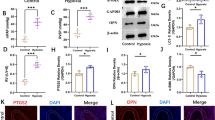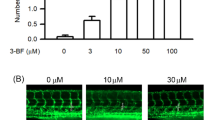Abstract
Nucleolin plays important roles in chromatin structure, rDNA transcription, rRNA maturation, nucleocytoplasmic transport, and ribosome assembly. Although it has been shown to be anti-apoptotic, the underlying mechanisms remain unclear. In the current study, we first examined endogenous nucleolin expression in response to oxidative stress-induced apoptosis in human umbilical vascular endothelial cells (HUVECs). Flow cytometry and caspase activity assays showed that H2O2 treatment caused apoptosis of the cells; reverse-transcription polymerase chain reaction and Western blotting revealed the downregulation of nucleolin expression and increased protein cleavage during this process. Overexpression of nucleolin protein by transfecting cells with the full-length nucleolin cDNA inhibited apoptosis, but nucleolin deficiency brought about by transfection with antisense oligonucleotide increased apoptosis of HUVECs. Concurrently, the expression of the apoptotic protein gene Bax was also downregulated following nucleolin overexpression. All these results indicate an important negative regulatory role for nucleolin in the apoptosis of endothelial cells, likely involving the Bax pathway.






Similar content being viewed by others
References
Chao DT, Korsmeyer SJ (1998) BCL-2 family: regulators of cell death. Annu Rev Immunol 16:395–419
Derenzini M, Sirri V, Trere D, Ochs RL (1995) The quantity of nucleolar proteins nucleolin and protein B23 is related to cell doubling time in human cancer cells. Lab Invest 73(4):497–502
Ginisty H, Amalric F, Bouvet P (1998) Nucleolin functions in the first step of ribosomal RNA processing. Embo J 17(5):1476–1486
Hovanessian AG, Puvion-Dutilleul F, Nisole S, Svab J, Perret E, Deng JS, Krust B (2000) The cell-surface-expressed nucleolin is associated with the actin cytoskeleton. Exp Cell Res 261(2):312–328
Jiang B, Xiao W, Shi Y, Liu M, Xiao X (2005a) Heat shock pretreatment inhibited the release of Smac/DIABLO from mitochondria and apoptosis induced by hydrogen peroxide in cardiomyocytes and C2C12 myogenic cells. Cell Stress Chaperones 10(3):252–262
Jiang B, Xiao W, Shi Y, Liu M, Xiao X (2005b) Role of Smac/DIABLO in hydrogen peroxide-induced apoptosis in C2C12 myogenic cells. Free Radic Biol Med 39(5):658–667
Kito S, Morimoto Y, Tanaka T, Haneji T, Ohba T (2005) Cleavage of nucleolin and AgNOR proteins during apoptosis induced by anticancer drugs in human salivary gland cells. J Oral Pathol Med 34(8):478–485
Oltvai ZN, Milliman CL, Korsmeyer SJ (1993) Bcl-2 heterodimerizes in vivo with a conserved homolog, Bax, that accelerates programmed cell death. Cell 74(4):609–619
Otake Y, Sengupta TK, Bandyopadhyay S, Spicer EK, Fernandes DJ (2005) Retinoid-induced apoptosis in HL-60 cells is associated with nucleolin down-regulation and destabilization of Bcl-2 mRNA. Mol Pharmacol 67(1):319–326
Otake Y, Soundararajan S, Sengupta TK et al (2007) Overexpression of nucleolin in chronic lymphocytic leukemia cells induces stabilization of bcl2 mRNA. Blood 109(7):3069–3075
Schreiber E, Matthias P, Muller MM, Schaffner W (1989) Rapid detection of octamer binding proteins with ‘mini-extracts’, prepared from a small number of cells. Nucleic Acids Res 17:6419
Takagi M, Absalon MJ, McLure KG, Kastan MB (2005) Regulation of p53 translation and induction after DNA damage by ribosomal protein L26 and nucleolin. Cell 123(1):49–63
Wang KK, Jiang L, Yi YX et al (2004) Effect of heat shock response on the cleavage of nucleolin induced by oxidative stress. Zhong Nan Da Xue Xue Bao Yi Xue Ban 29(05):504–508
Wang KK, Jiang L, E SM, Liu K, Zhang LL, Liu MD, Xiao XZ (2005) Effect of nucleolin down-regulation on the proliferation and apoptosis in C2C12 cells. Zhong Nan Da Xue Xue Bao Yi Xue Ban 30(2):125–129
Acknowledgments
This work was supported by fundings from the National Natural Science Foundation of China (30700290), the Major National Basic Research Program of China (2007CB512007), and the Opening Fund of The State Key Laboratory Of Trauma Burns and Combined Injury (SKLKF200806).
Author information
Authors and Affiliations
Corresponding authors
Additional information
Bin Zhang and Haiyun Wang contributed equally to the study.
Rights and permissions
About this article
Cite this article
Zhang, B., Wang, H., Jiang, B. et al. Nucleolin/C23 is a negative regulator of hydrogen peroxide-induced apoptosis in HUVECs. Cell Stress and Chaperones 15, 249–257 (2010). https://doi.org/10.1007/s12192-009-0138-5
Received:
Accepted:
Published:
Issue Date:
DOI: https://doi.org/10.1007/s12192-009-0138-5




